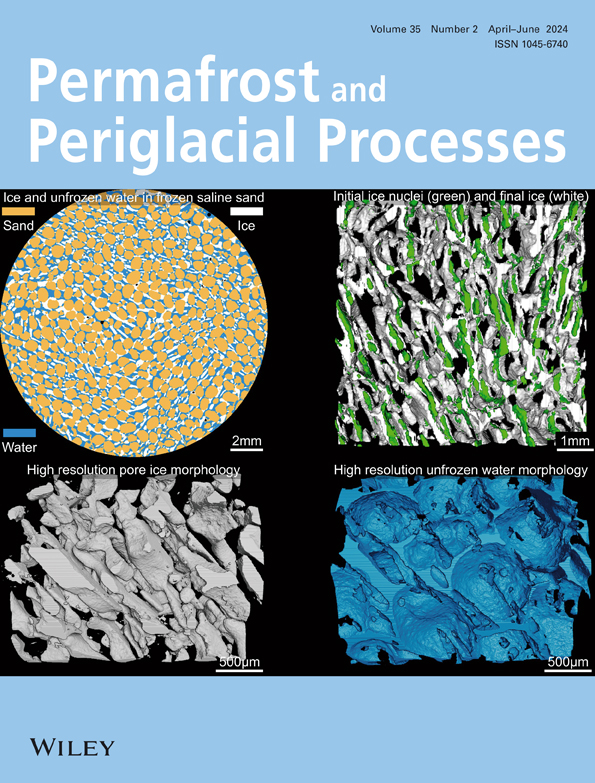劳里查德岩石冰川(法国阿尔卑斯山)40年来地表速度的变化
IF 3.3
3区 地球科学
Q2 GEOGRAPHY, PHYSICAL
引用次数: 7
摘要
自1983年以来,在法国阿尔卑斯山的岩石冰川上记录的地表速度最长的时间序列覆盖了30多年,这是在劳里查德岩石冰川(埃克林山脉)上记录的。从分离岩石冰川表面时空变化的方差分析中提取速度变化的时间信号,得到平均时间信号。我们表明,在岩石冰川作为一个整体的尺度上,所有地点的年速度变化实际上是均匀的,加速或减速都是均匀的。35年来,速度的空间结构几乎处于稳定状态。非线性效应位于低速区域,如岩石冰川边缘,在那里加速/减速往往与当地速度成正比。在有记录的时期内,岩石冰川加速的长期趋势为每十年+0.2米/年。从1980年代中期到1999年和2010年到2015年确定了两个主要的加速阶段。在这两个时期之间,有一个10年的速度几乎稳定的时期被打断,从2006年到2009年,速度突然减速为- 0.35米/年。单靠内部冰温升高的过程(以及相关的蠕变速率变化)似乎不足以解释地表速度的长期上升及其年变化。液态水的变化是一个可能的促成因素,这是由于积雪融化引起的季节性水的注入,或者是由于冰蠕变增强和冰/碎屑混合物摩擦产生的热量引起的内部融化。本文章由计算机程序翻译,如有差异,请以英文原文为准。
Changes in surface velocities over four decades on the Laurichard rock glacier (French Alps)
The longest time series of surface velocities recorded on a rock glacier in the French Alps, covering more than three decades, has been recorded since 1983 on the Laurichard rock glacier (Ecrins range). The time signal of velocity changes is extracted from variance analyses separating time and space variabilities on the rock glacier surface to provide an average‐wide time signal. We show that changes in velocity from year to year are virtually uniform at all locations with homogeneous accelerations or decelerations on the scale of the rock glacier as a whole. The spatial structure of velocity was found to be nearly at steady state over 35 years. Nonlinear effects are located in low‐velocity areas such as the rock glacier margins where accelerations/decelerations tend to be proportional to the local velocity. Over the period of record, a long‐term trend in rock glacier acceleration was detected with a rate of +0.2 m/yr per decade. Two main phases of acceleration were identified from the mid‐1980s to 1999 and from 2010 to 2015. In between, those two periods were interrupted by a 10‐year period of almost steady‐state velocities with an abrupt deceleration from 2006 to 2009 of −0.35 m/yr. The process of internal increases in ice temperatures alone (and associated changes in creep rates) would seem insufficient to explain the long‐term rise of surface velocities and their annual variations. Changes in the liquid water are a possible contributing factor, due to the injection of seasonal water caused by melting snow cover or internal melt due to heat generated by enhanced ice creep and friction in the ice/debris mixture.
求助全文
通过发布文献求助,成功后即可免费获取论文全文。
去求助
来源期刊
CiteScore
9.70
自引率
8.00%
发文量
43
审稿时长
>12 weeks
期刊介绍:
Permafrost and Periglacial Processes is an international journal dedicated to the rapid publication of scientific and technical papers concerned with earth surface cryogenic processes, landforms and sediments present in a variety of (Sub) Arctic, Antarctic and High Mountain environments. It provides an efficient vehicle of communication amongst those with an interest in the cold, non-glacial geosciences. The focus is on (1) original research based on geomorphological, hydrological, sedimentological, geotechnical and engineering aspects of these areas and (2) original research carried out upon relict features where the objective has been to reconstruct the nature of the processes and/or palaeoenvironments which gave rise to these features, as opposed to purely stratigraphical considerations. The journal also publishes short communications, reviews, discussions and book reviews. The high scientific standard, interdisciplinary character and worldwide representation of PPP are maintained by regional editorial support and a rigorous refereeing system.

 求助内容:
求助内容: 应助结果提醒方式:
应助结果提醒方式:


